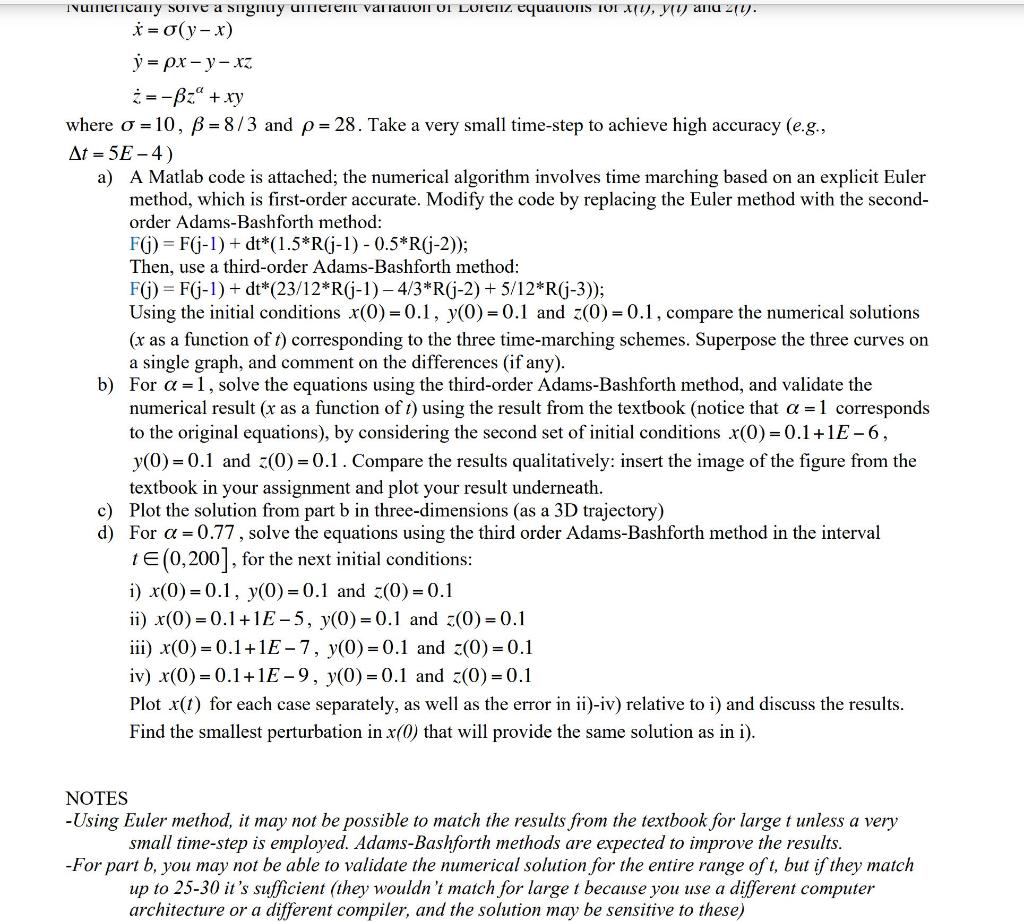I need to see Lorenz equation solved using adams bashforth method in matlab. Please add the code.
Inumerically solve a signty unterent variation Or Lorenz equations IOI MTU, Yuan Zu. * = o(y-2) y = px - y - XZ 3=-B=+ xy where o = 10, B = 8/3 and p = 28. Take a very small time-step to achieve high accuracy (e.g., At = 5E-4) a) A Matlab code is attached; the numerical algorithm involves time marching based on an explicit Euler method, which is first-order accurate. Modify the code by replacing the Euler method with the second- order Adams-Bashforth method: FG) = FG-1) + dt*(1.5*R(-1) - 0.5*R(-2)); Then, use a third-order Adams-Bashforth method: FC) = F(-1) + dt*(23/12*R(-1)-4/3*R(j-2) + 5/12*R(-3)); Using the initial conditions x(0)=0.1, y(0)=0.1 and z(0)=0.1, compare the numerical solutions (x as a function of t) corresponding to the three time-marching schemes. Superpose the three curves on a single graph, and comment on the differences (if any). b) For a=1, solve the equations using the third-order Adams-Bashforth method, and validate the numerical result (x as a function of t) using the result from the textbook (notice that a r1 corresponds to the original equations), by considering the second set of initial conditions x(0)=0.1+1E-6, y(O) = 0.1 and :(0) = 0.1. Compare the results qualitatively: insert the image of the figu from the textbook in your assignment and plot your result underneath. c) Plot the solution from part b in three-dimensions (as a 3D trajectory) d) For a=0.77, solve the equations using the third order Adams-Bashforth method in the interval 1 (0,200], for the next initial conditions: i) x(0)=0.1, y(0) = 0.1 and (0)=0.1 ii) x(0)=0.1+1E-5, y(0) = 0.1 and z(0) = 0.1 iii) x(0) = 0.1+1E-7, y(0)=0.1 and 7(0) = 0.1 iv) x(0) = 0.1+1E-9, y(0)=0.1 and z(0)=0.1 Plot x(t) for each case separately, as well as the error in ii)-iv) relative to i) and discuss the results. Find the smallest perturbation in x(O) that will provide the same solution as in i). NOTES -Using Euler method, it may not be possible to match the results from the textbook for large t unless a very small time-step is employed. Adams-Bashforth methods are expected to improve the results. -For part b, you may not be able to validate the numerical solution for the entire range of t, but if they match up to 25-30 it's sufficient (they wouldn't match for large t because you use a different computer architecture or a different compiler, and the solution may be sensitive to these) Inumerically solve a signty unterent variation Or Lorenz equations IOI MTU, Yuan Zu. * = o(y-2) y = px - y - XZ 3=-B=+ xy where o = 10, B = 8/3 and p = 28. Take a very small time-step to achieve high accuracy (e.g., At = 5E-4) a) A Matlab code is attached; the numerical algorithm involves time marching based on an explicit Euler method, which is first-order accurate. Modify the code by replacing the Euler method with the second- order Adams-Bashforth method: FG) = FG-1) + dt*(1.5*R(-1) - 0.5*R(-2)); Then, use a third-order Adams-Bashforth method: FC) = F(-1) + dt*(23/12*R(-1)-4/3*R(j-2) + 5/12*R(-3)); Using the initial conditions x(0)=0.1, y(0)=0.1 and z(0)=0.1, compare the numerical solutions (x as a function of t) corresponding to the three time-marching schemes. Superpose the three curves on a single graph, and comment on the differences (if any). b) For a=1, solve the equations using the third-order Adams-Bashforth method, and validate the numerical result (x as a function of t) using the result from the textbook (notice that a r1 corresponds to the original equations), by considering the second set of initial conditions x(0)=0.1+1E-6, y(O) = 0.1 and :(0) = 0.1. Compare the results qualitatively: insert the image of the figu from the textbook in your assignment and plot your result underneath. c) Plot the solution from part b in three-dimensions (as a 3D trajectory) d) For a=0.77, solve the equations using the third order Adams-Bashforth method in the interval 1 (0,200], for the next initial conditions: i) x(0)=0.1, y(0) = 0.1 and (0)=0.1 ii) x(0)=0.1+1E-5, y(0) = 0.1 and z(0) = 0.1 iii) x(0) = 0.1+1E-7, y(0)=0.1 and 7(0) = 0.1 iv) x(0) = 0.1+1E-9, y(0)=0.1 and z(0)=0.1 Plot x(t) for each case separately, as well as the error in ii)-iv) relative to i) and discuss the results. Find the smallest perturbation in x(O) that will provide the same solution as in i). NOTES -Using Euler method, it may not be possible to match the results from the textbook for large t unless a very small time-step is employed. Adams-Bashforth methods are expected to improve the results. -For part b, you may not be able to validate the numerical solution for the entire range of t, but if they match up to 25-30 it's sufficient (they wouldn't match for large t because you use a different computer architecture or a different compiler, and the solution may be sensitive to these)







